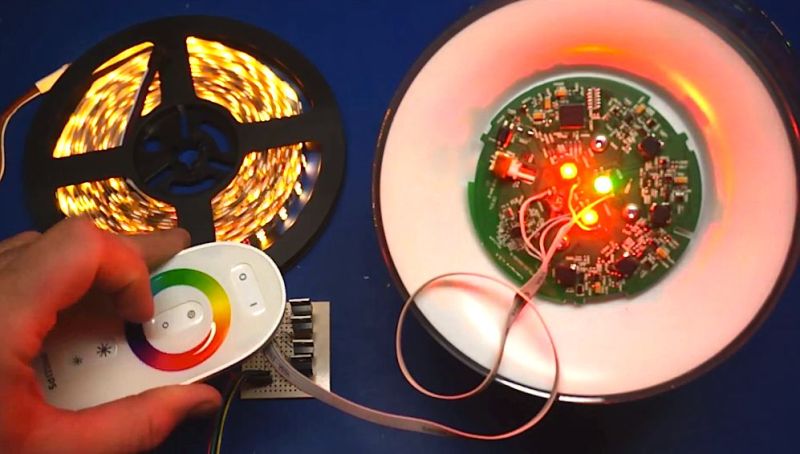[Martin] recently purchased a Philips LivingColors lamp. It’s a commercial product that basically acts as mood lighting with the ability to change to many different colors. [Martin] was disappointed with the brightness of his off-the-shelf lamp. Rather than spend a few hundred dollars to purchase more lamps, he decided to modify the one he already had.
[Martin] started by removing the front cover of his lamp. He found that there were four bright LEDs inside. Two red, one green, and one blue. [Martin] soldered one wire to the driver of each LED. These wires then connected to four different N-channel MOSFET transistors on a piece of protoboard.
After hooking up his RIGOL oscilloscope, [Martin] was able to see that each LED was driven with a pulse width modulated signal. All he had to do was connect a simple non-addressable RGB LED strip and a power source to his new driver board. Now the lamp can control the LED strip along with the internal LEDs. This greatly extends the brightness of the lamp with minimal modifications to the commercial product. Be sure to check out the video below for a complete walk through.
















Hm…iiiiiiidkk. I was kinda expecting to find out they were under driving leds. Meh, oh well.
Wouldn’t buy more lamps? Cheap bastar… Nah, this is a pretty cool hack, you can now drive an entire LED strip with the lamp, very nice.
It probably radiates RFI allover the neighborhood. You might choke off some with ferrite doughnuts and small caps at the source. Try .01 microfarad. The RFi may not cause buzzing or noise on an AM radio, but sometimes silence (your dead air) may be present. The lights should be at half brightness and then turn them on and off to at least scan the AM band for changes on the band the lights may make.
Otherwise a good hack without much work. No added ‘duino!
Near end of the video, on the LED strip near the person’s thumb, one of the LED seems dead.
I would have skipped the over priced lamp entirely. I have built a lot of really cool rgb lamps out of glass objects I have picked up for a $1 at goodwill and a 70 cent pic12f683, including sound responsive and radio controlled ones. At $2.50 a arduino nano clone and the ir library would make building a remote controlled lamp a breeze.
Nice mod but if anyone is thinking of replicating it, spare yourself the buyers remorse and just build one.
Anybody know why the LivingColors PCB seen at 0:30 has such a huge parts count? Seems quite a lot for RF (lower left?), controller (upper left?) and 4 drivers. If it weren’t for the SMT components, I would have thought I was looking at an eighties audio device. So many discrete components.